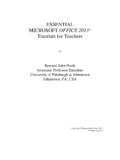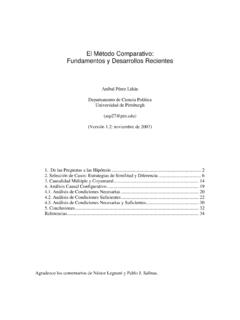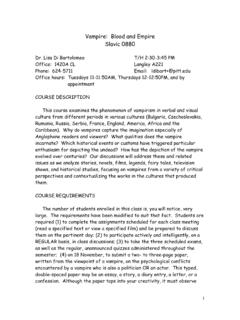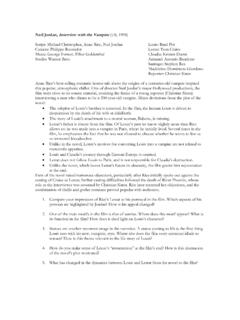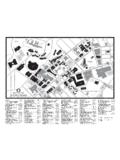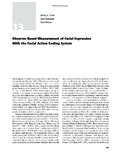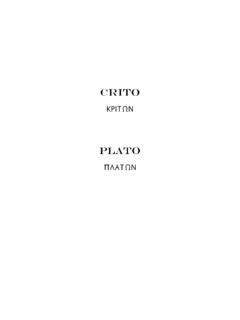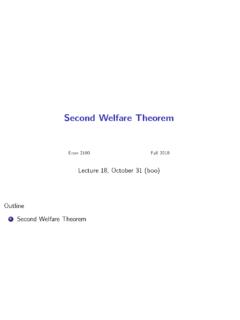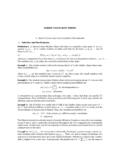Transcription of Stochastic Process and Markov Chains
1 1 Stochastic Process and Markov Stochastic Process and Markov ChainsChainsDavid TipperAssociate ProfessorAssociate ProfessorGraduate Telecommunications and Networking ProgramUniversity of Processes A Stochastic Process is a mathematical model for describing an empirical Process that changes in time according to some probabilistic A Stochastic Process is a family of random variables {X(t), t T} defined on a given probability space S, indexed by the parameter t,where t is in an index set T. For each t T, X(t) is a random variable with F(x,t) = P{X(t) x} A realization of X(t) is called a sample pathTelcom 21302 A realization of X(t) is called a sample path Characterization of a Stochastic Space S, set of Stochastic Processes State Space The values assumed by a random variable X(t)are called states and the collection of all possible values pforms the state space S of the Process .
2 If X(t)=i, then we say the Process is in state i. Discrete-state Process The state space is finite or countable for example the non-negative integers {0, 1, 2,..}. Continuous-state processTelcom 21303 Continuousstate Process The state space contains finite or infinite intervals of the real number of Stochastic Processes Index parameter The index T is usually taken to be the time parameter. Discrete-time processDiscretetime Process A Process changes state (or makes a transition ) at discrete or finite countable time instants. Continuous-time Process A Process may change state at any instant on the time axis.
3 The probability that Stochastic Process X takes on a valuei()at time=tis P[X(t)=i]STelcom 21304a value i() at time= t is P[X(t)=i] Stationarity A Stochastic Process X(t) is strict sense stationary if the statistical properties are invariant to time shifts f(x,t) = f(x) for all 3 Characteristics A Stochastic Process X(t)is wide sense stationary if 1. Mean is constant E{X(t)} = K for all t2. The autocorrelation R is only a function of the time difference R(t1, t2) = R(t2 t1) = R( ) Ergoditcity A Stochastic Process X(t)is ergodic if it s ensemble averages equal time averages => Any statistic of X(t)can be found from a sample pathTelcom 21305 TTdttxTdxtxxftXE0)(1lim),()
4 }({Categories of Stochastic ProcessesTime PtState SpaceParametersDiscrete StateContinuous StateDiscrete TimeDiscrete time Stochastic chainDiscrete time Stochastic processTelcom 21306 Continuous TimeContinuous time Stochastic chainContinuous time Stochastic process4 Stochastic ProcessesTelcom 21307 Stochastic Processes Important Stochastic Processes for Queueing System Analysis Markov Chains Markov Process Counting Process - Poisson Process Birth Death Process In 1907 A A Markov defined and investigated a8 In 1907 Markov defined and investigated a particular class of Stochastic processes now know as Markov processes/chains5 Markov Process For a Markov Process {X(t), t T, S}, with state space S,its future probabilistic development is dependent only on the current state, how the py, Process arrives at the current state is irrelevant.)
5 Mathematically The conditional probability of any future state given an arbitrary sequence of past states and the present state depends only on the current state Telcom 21309 Memoryless property- The Process starts afresh at the time of observation and has no memory of the Time Markov Chains The Discrete time and Discrete state Stochastic Process {X(tk), k T} is a Markov chain if the following conditional probability holds for all i, jand k. (note Ximeans X(ti))P[Xj|XiXiXiXi]P[ Xk+1= j | X0= i0, X1= i1,.., Xk-1= ik-1, Xk= i]= P[ Xk+1= j | Xk= i]= pi j(k) state transition probability at kthtime step The future probability development of the chain depends only on its current state (kthinstant) and not on how the chain has arrived at the current state ( , memoryless)Telcom 2130106 Discrete Time Markov Chains (2) pi j (k) is (one-step) transitional probability, which is the probability of the chain going from state i to state j at time steptkstate j at time step tk pi j (k) is a function of time tk.
6 If it does not vary with time (independent of k), then the chain is said to have stationary transition probabilities and is time homogeneous pi j (k) = pij for all kpijis the one step transition probability of goingTelcom 213011pij is the one step transition probability of going from state i to state j The state transition matrix P = [pij] characterizes the Markov chain . Discrete Time Markov Chains (2) The one step state transition matrix P = [pij] is a Stochastic matrix10 pij 1 All elements between zero and pij 1 All elements between zero and row sums to one and is a density function = 1 is an eigenvalue of P and | j | < 1 j = 2, 3.
7 Sjijp1 KKKK pppppppppppppp11114131211100100403020100 Telcom 213012 KKKKKKKKKKKKK pppppppppppppppppppppppP,1,4,3,2,1,0,343 332212242322211111413121110 7 Discrete Time Markov Chains (2) For small state space can represent state transition matrix P = [pij] as a state transition diagramdiagramConsider the Time Homogeneous Markov chain with one step transition matrix for the states {0, 1, 2, 3} given below. 213013 chain Analysis Summary Markov chain one step transition matrix state probabilities :kxtkN ijPp npxtj state probabilities General/transient behavior1)with computation 2)with computation3)with computation jnpxtj 00nnnpp 1nnp 2 OnN 22logOnN 3ON 001diagnnninpTT 1 Telcom 213014where Also P(n)the n step transition matrix is P(n)= (P)n Steady state behavior 4)and 11 modal matrixTm limnn p 1iiS 8 Markov chain Analysis Summary 5.
8 First Passage Time The first passage time Tijis the number of transitions required to go from statei to state jfor the first time (recurrence time if i = j). Letf(n)=P{T= n} That is probability the first passage time is n stepsLet fij(n)= P{Tij = n} . That is probability the first passage time is n steps })(|1,,,2,1,)(,)({)(itxnrjtxjtxPfkrknkni j )1()2()2()1( pfpfpfjjijijijijijTelcom 213015,..3,211)()()()( npfpfnkknjjkijnijnij Markov chain Analysis Summary 6. Mean First Passage TimeThe Mean First Passage Time E{Tij} is the average number of transitions required for the Markov chain to go from statei to state jfor the first time (recurrence time ifi=j)the first time (recurrence time if i j).
9 Using probability generating function approach get )(1}{nijnijfnTE eRITE jjij10)(][ Telcom 213016 Where pj0= [0, ..0, 1, 0, ..0] is one only in the ithelement andRj= [Pik] one step transition matrix P withoutrow j and column jjkji ,9 Markov chain Analysis Summary 7 Transform approach to n) and P n)Pnn)1()( 11)0()0()1()()()()()( zPIZPZzZPZZznn Telcom 213017 1)( zPIPnMarkov chain Analysis Summary 8. State Holding TimesLet Hibe the random variable that represents the number of time slots the Markov chain spends in stateinumber of time slots the Markov chain spends in state i Note the holding time has a geometric distribution which11211)1(})(|)({}.
10 (|)({})(|)({})(|1,,,2,1,)(,)({}{ niiiikknknknknkkrknkippitxitxPitxitxPitx jtxPitxnritxjtxPnHPTelcom 213018 Note the holding time has a geometric distribution which is the only memoryless discrete model of a discrete time bursty ATM traffic source is a two state markovchain with one state representing ON and the other state representing OFF. When the source is in the ON state a cell is generated in every slot, when the source is in the OFF state no cell is generatedMarkov chain Examplesource is in the OFF state no cell is generated. Let be the probability of transition from ON to OFFLet be the probability of transition from OFF to ONThe probability of making a transition from a state back to itself are and respectively for ON and OFFThe state transition diagram and state transition matrix P areat1a 1t Telcom 213019at 1a 1t 1-a 1-tapt ONOFFONOFFD etermining the steady state probabilities 1 ONONOFFata.)}
